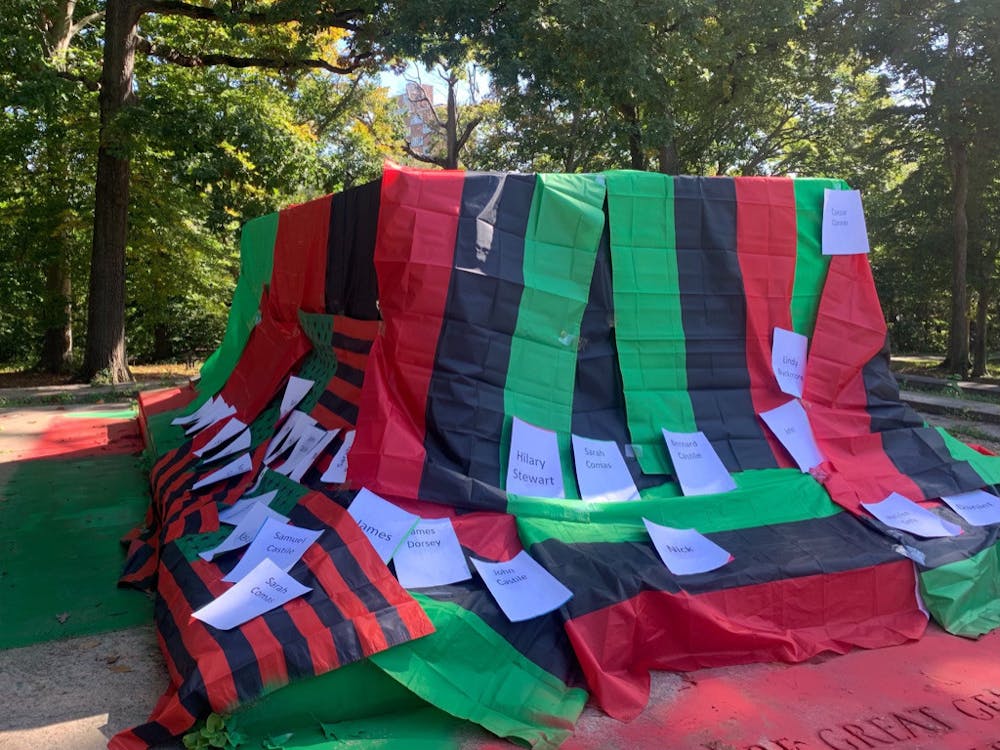Inheritance Baltimore hosted a Walk of Remembrance on Oct. 14 to honor the lives and legacies of those who were enslaved on Homewood Campus. The Walk of Remembrance began at the Homewood museum and ended at the Tubman Memorial Garden.
The event followed the inaugural Ritual of Remembrance held in January of 2022, which honored the work of Black ancestors on Homewood who contributed towards building the present day institutions.
In an interview with The News-Letter, Jasmine Blanks Jones, a postdoctoral fellow in the Racism, Immigration, and Citizenship program, emphasized that Hopkins has fallen behind its institutional peers in terms of acknowledging the history of slavery on its campus.
“Princeton [recognized its own history of slavery] more than a decade ago,” she said. “Hopkins has just been digging into this over the last six years or so.”
According to Jones, Inheritance Baltimore recognized the importance of sharing the names of those enslaved on the Homewood Campus with the Baltimore community as soon as they discovered the names.
Jones described how Inheritance Baltimore decided to honor the names of those who were enslaved through rituals because of their connections to African descent.
“[The right path] was definitely through the humanities, through music, through the arts [and] backed by social sciences,” she said. “[The walk is] out of that spirit of wanting to do the educative and reparative work of making sure that people can know who their ancestors were and what great work they did to make our campus and our intellectual community.”
The walk featured a monologue performed by sophomore Yasmine Bolden, a tap dance performance by Briane Ali and a speech from local Baltimore educator Charlie Dugger. There were also two interactive art installations led by Jeneanne Collins, a community arts fellow at Inheritance Baltimore.
The event began with Bolden’s monologue where she assumed the identity of an enslaved person living on the Carroll family property, which is now used as the Homewood Museum.
Bolden and Dugger led the audience in proclaiming the names of those who were enslaved on the property. Dugger poured a libation of water into a plant to honor their lives and legacies.
Attendees then walked to an orchard near the Homewood Museum, where they placed stakes containing the written names of those who were enslaved into the ground. Collins designed the installation to represent an area where those who were enslaved might have gathered, recalling their humanity during a time when they were treated like commodities.
A drum procession played as attendees walked from the orchard to the Tubman Memorial Garden. Once there, Collins described her vision for the temporary art installation at the garden.
“I drew inspiration from the artifacts; that’s a key point for me,” she said. “This represents the cloth of who we are.”
Dugger followed Collins' comments by highlighting the importance of remembering and honoring Black ancestors.
“We elevate our ancestors, who made [Hopkins] possible [and] made Baltimore be the thriving metropolis that it is, but we also have to keep on loving and sharing with each other,” he said.
Ali then took the stage to tap dance. She dedicated a dance to Baby Laurence, a jazz tap dancer from Baltimore who had a strong influence on the art form.
She noted that Laurence’s impact has been neglected because of his struggles with addiction.
“Everyone has some type of traumatic event that sometimes puts us in the wrong mindset. We make bad decisions, and he had an addiction problem, and a lot of people knew that,” she said. “That was the very thing that kept us from knowing more about him, so I’m determined to re-write his bio to preserve and tell his story.”
The event closed as attendees completed Collins’ installation by taping pieces of paper with the names of those who were enslaved on Homewood to the pan-African flags, which are laid over a removed Confederate monument.
In an interview with The News-Letter, sophomore Zari Newman described her reflections from joining the walk.
“It makes me want to be more connected and engaged within the Black Baltimore community,” she said. “I just feel a deeper appreciation for the people who worked on this campus and have allowed me to be here in this moment.”
Visiting Professor Andrew Jewett, who is a member of a team writing an institutional history of Hopkins, attended the event to gain a better understanding of the University’s history. In an interview with The News-Letter, he praised the University’s efforts to acknowledge its history.
“I’m so glad to see that Hopkins is thinking in so many different ways about its past, including the less pleasant parts of its past,” he said. “[Thinking about] questions about oppression and violence that have happened here in this space and long before Hopkins as an institution existed [is] really powerful work.”
Editors Note: Jasmine Blanks Jones’ comments have been edited for accuracy.





